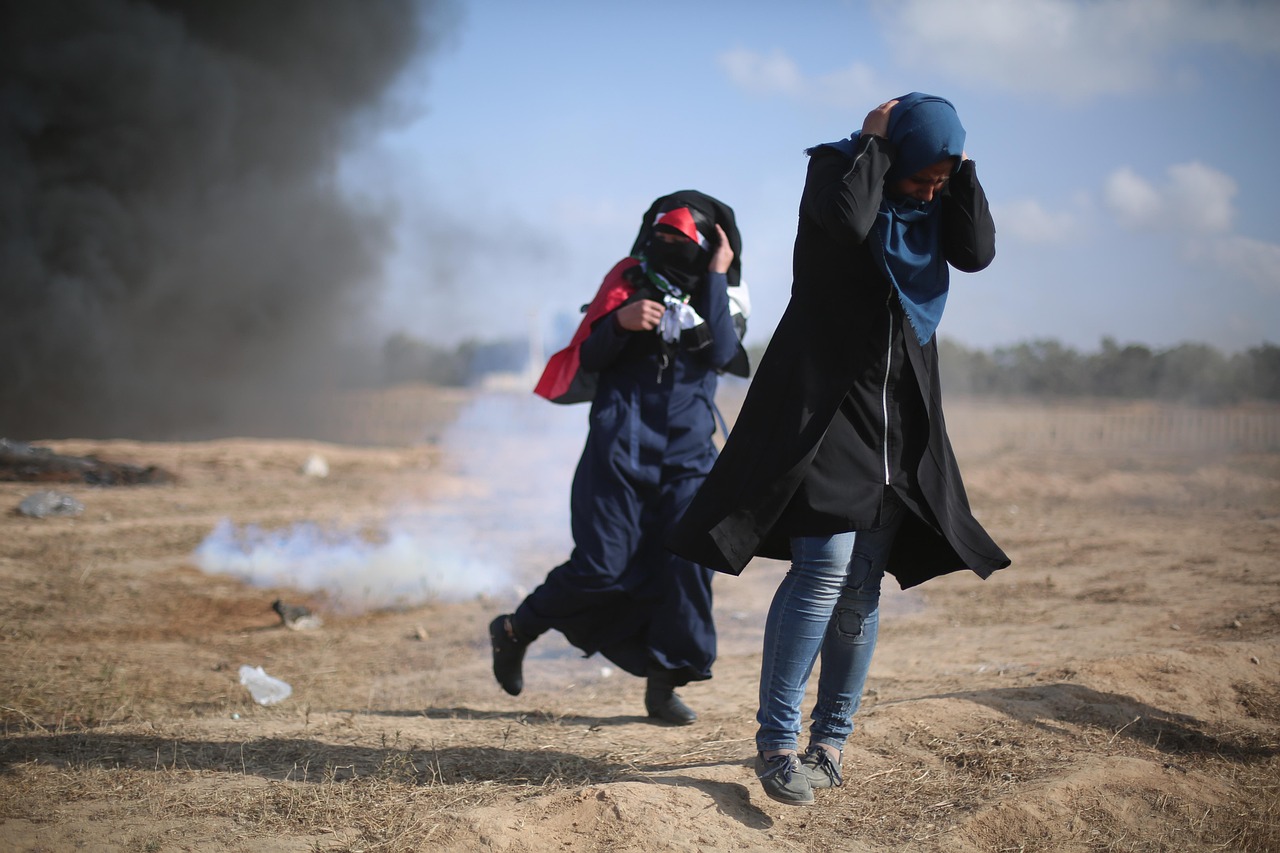Recalibrating the Proportionality Calculus to Include Mental Collateral Damage (IHL Symposium)

Source: Hosny Salah
This piece is part of the American Branch’s third blogging symposium, examining the ILW 2025 theme of ‘Crisis as Catalyst in International Law’ from an International Humanitarian Law perspective. The International Humanitarian Law Committee sponsors this symposium; however, the views expressed in published works are solely those of the authors.
Recalibrating the Proportionality Calculus to Include Mental Collateral Damage
by Natasha Arnpriester*
In a Gaza shelter, a displaced child tells a mental health worker: “I think I am dead, but if you can hear me, maybe I am alive.” This is dissociation, an acute psychological response from a young mind overwhelmed by war.
This single moment distills a wider catastrophe. In Gaza, nearly 84% of civilians meet the diagnostic criteria for post-traumatic stress disorder (PTSD), and almost 90% suffer significant psychological distress. The World Health Organization has called the mental toll “unspeakable,” as children endure nightmares, bedwetting, mutism, acute anxiety, and physical pain rooted not in physical injury, but mental trauma.
International Humanitarian Law (IHL) restrains harm in armed conflict by regulating how it is fought, balancing military necessity with the imperative to protect civilians from unnecessary suffering. At its core is the principle of proportionality, which prohibits attacks when the expected civilian harm, so-called “collateral damage,” would be excessive in relation to the anticipated military advantage.
IHL defines collateral damage as the “incidental loss of civilian life, injury to civilians, and damage to civilian objects.” But “injury” here is understood only in physical terms. Injuries that are psychological in nature do not count.
Operationally, the principle of proportionality functions like a scale: if anticipated civilian harm outweighs the military gain, the attack is unlawful; if not, it may proceed. But by excluding mental harm from this calculation, the law blinds itself to one of war’s most devastating and enduring consequences.
Psychological injury in armed conflict is not anecdotal, but an epidemiological reality. PTSD, for instance, whether triggered by direct threats or by witnessing harm to others, can hollow out a life from within. It drives people into isolation, robs them of their livelihoods, traps them in a state of unrelenting fear, fuels addiction, and pushes some to the brink of suicide.
The data is stark. In Afghanistan, decades of conflict have produced some of the highest global rates of trauma, anxiety, and depression, even among those never physically injured. In Ukraine, the share of civilians with PTSD symptoms surged from 27% before the full-scale invasion to 74%. In Yemen, one in four people lives with war-inflicted psychological trauma. Among Syrian refugees in Germany, around half live with PTSD, and 40% have contemplated or attempted suicide. After the Gulf War, more than 70% of Kuwaiti children developed PTSD; among a sample of war-affected Kurdish children, the figure reached a staggering 87%.
And mental harm often becomes physical. It raises the risk of heart disease, stroke, cancer, and other serious illnesses. In Beirut, civilians exposed to war trauma were two to three times more likely to die prematurely than those spared such exposure. Neuroscientific studies show that psychological trauma can alter brain chemistry and even its physical structure in ways that degrade physical health over time.
Psychological injury in war is not new. Accounts stretch from ancient Mesopotamia to “shell shock” in World War I. But modern military technology has diversified, and, in some cases, intensified that trauma.
Take combat drones. Praised for their precision and supposed ability to spare civilians, they are often portrayed as a cleaner form of warfare. Yet this claim rests on an incomplete calculus. Judged only by immediate physical harm, drones may seem benign; measured by their psychological toll, they can be devastating.
Mental health experts have described the U.S. drone program as causing suffering on an “unprecedented scale,” with civilians exhibiting high rates of depression, anxiety, hallucinations, psychosis, and schizophrenia. A joint report by Stanford and New York University law schools documented communities under constant drone surveillance and strikes enduring severe emotional breakdowns, exaggerated startle responses, withdrawal, hallucinations, and suicidal ideation. In Yemen, a psychologist found 92% of residents in drone-affected areas met the criteria for PTSD. In Ukraine, “droneophobia” has entered the popular lexicon, as psychiatrists report a surge in “mental health injuries” tied directly to drone exposure. Experts liken these psychological scars to those of torture victims—people subjected to “inescapable and uncontrollable stressor events.”
Drone warfare lays bare the glaring gap in the current IHL proportionality analysis. Under prevailing interpretation, a strike expected to kill only a combatant and cause no physical civilian injury is deemed entirely lawful. Yet if mental harm were counted as collateral damage, some such operations would fail a proportionality test.
When no physical injury is anticipated, proportionality almost always tips toward military necessity, even if the psychological toll is widespread and severe. In this blind spot, even a trivial military gain outweighs what the law records as “zero” civilian harm. That legal green light can be given again and again: a strike in the morning, another at noon, another at night, day after day, each one deemed lawful, while civilians live in constant terror.
On paper, the harm does not exist. In reality, it is measurable, profound, and often as devastating as any physical wound. And as weapons and targeting systems grow ever more precise, the risk of overuse only grows precisely because physical damage appears reduced.
Closing this gap matters. Incorporating mental harm into the collateral damage calculus would compel more discriminating operational choices, forcing decision-makers to weigh military necessity against the full spectrum of civilian suffering; sparing countless civilians from an injury that may be invisible, yet no less real.
Critics may argue that psychological harm is too diffuse or unpredictable to factor into proportionality. Yet proportionality assessments already operate under uncertainty. Military decision-makers routinely forecast civilian harm and anticipated military advantage with incomplete data. The same is true in psychology, where researchers regularly model mental harm using established diagnostic criteria, population surveys, and predictive epidemiology. Difficulty in measurement does not erase the fact that psychological harm is real, foreseeable, and, like physical harm, susceptible to reasonable estimation.
There are workable ways to estimate, or at least meaningfully consider, potential psychological harm. One practical starting point could be to adapt the “zone of impact” approach long used in U.S. tort law and disaster compensation. Under the “zone of danger” rule, plaintiffs can recover damages for emotional distress without physical injury if they were in an area of immediate risk of physical harm. After the September 11 attacks, the federal Victim Compensation Fund operationalized this, recognizing PTSD, depression, and anxiety as compensable harms for those within a defined “exposure zone,” regardless of physical injury. Those who lost loved ones, witnessed the attacks, or endured the ongoing fear of another strike suffered in ways similar to civilians in war zones.
This framework could be adapted ex ante in armed conflict. First, define the anticipated exposure zone for an operation, whether the blast radius of a missile or the geographic reach of bombardment. Second, estimate the civilian population within that zone. Third, apply epidemiological data from comparable contexts to project the likely prevalence and severity of psychological harm. For example, if a planned drone surveillance operation is projected to cover a town of 5,000 people for several months, prior research from similar environments could indicate that up to 60%, or 3,000 civilians, might develop PTSD or related disorders, even absent physical injury. These projections could then be incorporated into the proportionality analysis alongside anticipated physical casualties and damage to civilian objects.
While the finer points of quantification require further scholarship, the imperative is clear: psychological injury is measurable enough to matter, predictable enough to plan for, and grave enough to demand inclusion in the law’s most consequential battlefield calculus. The growing body of international legal scholarship examining how and why mental harm should be incorporated into proportionality analysis (particularly here, here, and here) is adding important depth to what remains an underdeveloped but vital conversation.
The very purpose of IHL is to limit human suffering, whether inflicted on the body or inscribed on the mind. International law recognizes no distinction, enshrining in the jus cogens ban on torture the condemnation of the deliberate infliction of “severe pain or suffering, whether physical or mental” at the highest level of legal authority. And as “mental torture” is expressly prohibited in Article 17 of the Third Geneva Convention and deemed a grave breach under Article 130 (see also Additional Protocol I, Art. 85(5)), the mental devastation of war must weigh as heavily as physical harm in assessing proportionality, in both moral and legal terms.
The laws of war are meant to preserve a thread of humanity even in humanity’s darkest hour. Yet by defining collateral damage only in physical terms, the proportionality test ignores some of the most devastating consequences of modern conflict. A scale that weighs only deaths and physical injuries tilts IHL’s balance towards military necessity, thus eroding its commitment to humanity.
Recalibrating proportionality to account for psychological injury would not weaken military effectiveness; it would strengthen the law’s legitimacy, ensuring that the shield it promises to civilians is not pierced by wounds it refuses to see. Wars will always exact a cost. If we insist that cost is justified, then we must count every harm, including the ones the law, as presently applied, leaves uncounted.
 *Natasha Arnpriester is Senior Legal Counsel at the Open Society Justice Initiative in New York, where she leads transnational litigation on human rights accountability, with a particular focus on communities affected by armed conflict, authoritarian regimes, and structural exclusion. Her litigation strategies center on developing niche and innovative arguments to address complex problems in both domestic and international legal forums, with impacted communities at the core.
*Natasha Arnpriester is Senior Legal Counsel at the Open Society Justice Initiative in New York, where she leads transnational litigation on human rights accountability, with a particular focus on communities affected by armed conflict, authoritarian regimes, and structural exclusion. Her litigation strategies center on developing niche and innovative arguments to address complex problems in both domestic and international legal forums, with impacted communities at the core.



